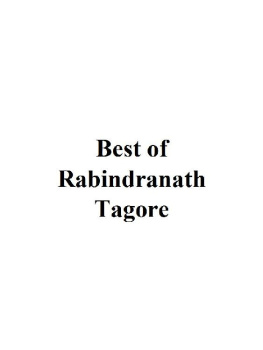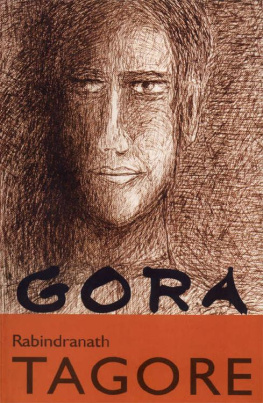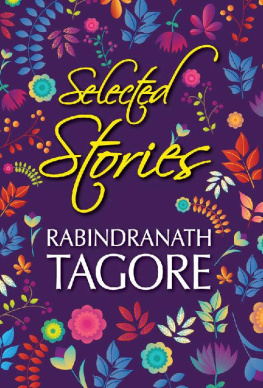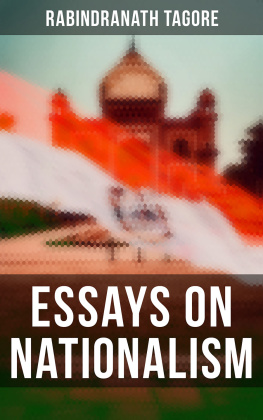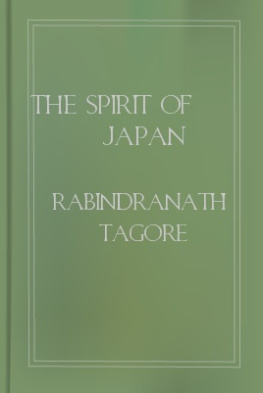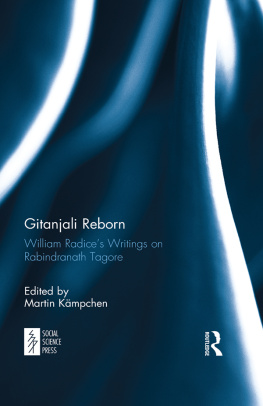RABINDRANATH TAGORE
Gitanjali
Song Offerings
a new translation
by
William Radice
with an Introduction
and a new text of Tagores translation based on his manuscript

PENGUIN BOOKS
PENGUIN BOOKS
Published by the Penguin Group
Penguin Books India Pvt. Ltd, 11 Community Centre, Panchsheel Park, New Delhi 110 017, India
Penguin Group (USA) Inc., 375 Hudson Street, New York, New York 10014, USA
Penguin Group (Canada), 90 Eglinton Avenue East, Suite 700, Toronto, Ontario, M4P 2Y3, Canada (a division of Pearson Penguin Canada Inc.)
Penguin Books Ltd, 80 Strand, London WC2R 0RL, England
Penguin Ireland, 25 St. Stephens Green, Dublin 2, Ireland (a division of Penguin Books Ltd)
Penguin Group (Australia), 250 Camberwell Road, Camberwell, Victoria 3124, Australia (a division of Pearson Australia Group Pty Ltd)
Penguin Group (NZ), 67 Apollo Drive, Rosedale, Auckland 0632, New Zealand (a division of Pearson New Zealand Ltd)
Penguin Books (South Africa) (Pty) Ltd, Block D, Rosebank Office Park, 181 Jan Smuts Avenue, Parktown North, Gauteng 2193, South Africa
Penguin Books Ltd, Registered Offices: 80 Strand, London WC2R 0RL, England
First published in India by Penguin Books India 2011
Translation and introduction copyright William Radice 2011
Cover photograph Tamara Kulikova/ shutterstock.com
Cover design by Saurav Das
All rights reserved
ISBN: 978-06-7008-542-2
This digital edition published in 2012.
e-ISBN: 978-81-8475-145-1
This book is sold subject to the condition that it shall not, by way of trade or otherwise, be lent, resold, hired out, or otherwise circulated without the publishers prior written consent in any form of binding or cover other than that in which it is published and without a similar condition including this condition being imposed on the subsequent purchaser and without limiting the rights under copyright reserved above. No part of this publication may be reproduced, stored in or introduced into a retrieval system, or transmitted in any form or by any means (electronic, mechanical, photocopying, recording or otherwise), without the prior written permission of both the copyright owner and the above-mentioned publisher of this book.
to
the many people in India and Britain who helped me to complete this book
with special thanks to
Dr Manas Kumar Bhattacharya, Professor D.P. Baksi and
Dr Debadyuti Baksi (orthopaedic surgeons),
Dr Deepa Banerjee (anaesthesiologist), and
Mr Ayananta Dalal (physiotherapist)
tomr sonr thly sjba j dukher arudhr
(Gitanjali 80/83)
In green India among quiet
trees that bend over blue water
lives Tagore
In Green India, in Look Back, Look Ahead: The Selected Poems of Sreko Kosovel,
translated by Ana Jelnikar and Barbara Siegel Carlson
Gitanjali Reborn
Gitanjali: Song Offerings, as translated by Rabindranath Tagore in his famous book of 1912, has been with us for a century and has been further translated into all the major languages of the world. It is a book that many readers feel they already know. In this new book, commissioned by Penguin India for the one-hundred-and-fiftieth anniversary of Tagores birth, I offer Gitanjali in a new incarnation. A brief overview may be helpful.
- The present volume contains an entirely new translation of all the poems that were in Tagores English book Gitanjali, which was a different book from his Bengali Gitanjali of 1910. The English Gitanjali overlaps with the Bengali book by just over half, but the other poems in the collection were taken from a number of other Bengali books by Tagore.
- My new translation attempts to distinguish the various styles and forms in the Bengali original that Tagore was not able to convey in his own, prose translations. Sonnets I translate as sonnets; ballads I translate as ballads; in all the poems where metre and rhyme are important I try to find flexible English equivalents. The songs, however (many of the poems in Gitanjali are songs), I have translated in a way that I hope will instantly convey their song-like character. I preserve the repetitions of the lines that are obligatory when the songs are sung, I indicate the four-part structure of the song by inserting line-breaks, and I also put the second and fourth part of the song in italics. This is to evoke the way in which, in almost any song by Tagore, the fourth part has the same melody as the second part.
- Alternating with my translation is an entirely new text of Tagores own translation. This follows not the standard text that was published in 1912, introduced and edited by W.B. Yeats, but the manuscript that has been preserved among the William Rothenstein papers at Harvard. This manuscript has 83 poems, as opposed to the 103 in the published text, and their order is quite different. Both my own translation and my new text of Tagores follow the manuscript order, restoring three poems that were dropped when Gitanjali was published. The remaining poems are given in a section called Additional Poems. They include three that were on spare pages at the end of the Rothenstein manuscript, and twenty more from other sources. One of those sources may have been a second manuscript volume (now lost), but twelve of the twenty have been preserved in a separate bundle of manuscripts at Harvard, known as the Crescent Moon Sheaf.
- My long Introduction explains the complex relationship between the manuscript and the published text, and argues that a text that follows the manuscriptwith minimal adjustmentsbrings us much closer to Tagores original conception of the book. The shortcomings and distortions of the standard text are explored in further detail in Appendices to the book. One of these (actually show Yeatss emendations. (The typed copy on which Yeats made the bulk of his changes is lost.)
- Finally, so that readers are able to compare in one volume my new translation, Tagores translation based on the manuscript (with my own editorial adjustments referenced in footnotes), and the text with which they may already be familiar, gives the standard Macmillan text as printed in the Collected Poems and Plays of Rabindranath Tagore in 1936, and also gives Yeatss Introduction.
For those who already know and love Gitanjali, this book may offer a novel and perhaps unnerving experience. But if Gitanjali is to win new readers and admirers in the second century of its existence, it needs to take on an avatar that is suited to our age, as well as restoring to Tagore the real Gitanjali, a poetic endeavour that he cared about deeply, but which Yeatss editing, the Nobel Prize, the numerous secondary translations and the canonical status that it acquired, rather took out of his hands.
W.R.
Introduction
These poems of mine are very different from other literary productions of the kind. They are revelations of my true self to me. The literary man was a mere amanuensisvery often knowing nothing of the true meaning of what he was writing
Letter from Rabindranath Tagore to William
Rothenstein, 30 December 1912
1.
A new translation of Rabindranath Tagores most famous book Gitanjali seems timely because of three consecutive anniversaries. 2011 is the one-hundred-and-fiftieth anniversary of Tagores birth in 1861. 2012 is the centenary of the publication of Tagores own translation of



